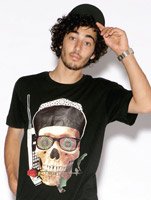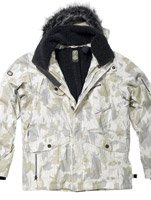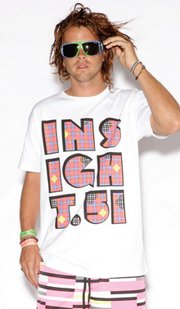Surf Goes Street
It wasn’t too long ago thatsurfwear companies groused about pretenders to their throne. Companies such as Hollister, a New Albany, Ohio–based retailer of surf-inspired apparel with no real ties to the surf culture, and its parent company, Abercrombie & Fitch, the mall-based purveyor of preppy/beach styles, were taking cues from the surf industry and eating away at its customer base. “At one point, even Tommy Hilfiger tried to do the surf thing, and we, as an industry, laughed at them. It was pretty ridiculous,” said Joe Knoernschild, a former principal and founding partner of Billabong USA and Hurley.
Now the surf industry, which the Surf Industry Manufacturers Association tallied at $2.65 billion in 2006, is feeling pressure from a new challenger. Streetwear, the edgy fashion targeting the men’s youth market with military-inspired jackets, graphic T-shirts, slim-fit jeans and hoodies spun into fashion, is steadily encroaching on the once-isolated core surf market. Skate, which enjoys a close connection to streetwear, was once surf’s little brother. In the last two years skate has seen marked growth, swelling from $2.41 billion in 2004 to $2.85 billion in 2006, easily outpacing surf.
“Fashion, in the shape of streetwear, is penetrating the boardsports market, but surf companies, which have always had fashion pieces in their lines, simply haven’t established themselves as real fashion brands,” said Larry Castro, Insight USA’s national sales manager. Now, traditionally core retailers, who in the past stocked only surf and skate brands, have begun turning to streetwear brands to keep up with the trends. That’s troubling for surf brands, which, despite their popularity, have limited channels of distribution. “When surf brands see real estate on their retailers’ sales floor going outside the industry to streetwear brands, there is a problem,” said Aaron Levant, founder of the Agenda streetwear trade show and of the Los Angeles–based showroom of the same name.
With street-wear emerging as the dominant trend and a direct competitor, many surf brands are looking to co-opt the streetwear look. On the show floor at the Action Sports Retailer Trade Expo in San Diego last month, the aesthetic was decidedly less surf even in the most core of brands. True surf staples such as cargo shorts, branded T-shirts, embroidered shirts and loose silhouettes were secondary to the more lean-and-clean street fashion. For Spring 2008, surfers will look like streetwear aficionados with fitted plaid thermal shirts, slim corduroy pants, army-green jackets, striped knits and plenty of ’80s neon pop graphics—if they buy what surf is serving.
While many surf-industry figures agree that surf has taken on a distinctly street flavor, they are divided on what it means for the industry. One camp argues that surf—as part of fashion—must change with the trends. Another points to the streetwear evolution as the natural growth of surf and surfers beyond the beach. Still others—streetwear designers included—point to surf’s streetwear attempts as evidence that surf, once the king of innovative fashion, is stagnating.
Fashion-focused
There is a history of brands with surf roots joining the ranks of fashion. Stuuml;ssy, the Irvine, Calif.–based streetwear brand, was founded in 1980 by surfboard shaper Shawn Stuuml;ssy and partner Frank Sinatra. “By 1985, Stussy had begun its evolution into a streetwear brand,” Sinatra said. Now a bona fide member of the elite streetwear scene, Stuuml;ssy is at the forefront of the current streetwear craze. And, while Stuuml;ssy keeps its distance from the surf industry, today’s surf brands look to the company as an example of how a surf brand can grow beyond the board shop into a true fashion label. In its wake, brands such as Insight, Volcom and RVCA have found ways to grow their appeal beyond the core market through fashion.
“When most other brands started, they started with just surf. That makes it hard to branch out,” said Rick Lohr, director of men’s design at Volcom. “Volcom came out with a crossover platform that included surf, skate and snow. So, from the very beginning we’ve had more room to maneuver.” Good design, excellent marketing and strong sales propelled the brand, whose motto remains “Youth Against Establishment,” to a successful initial public offering in 2005. With its resources and high expectations, Volcom sells street fashion to core stores and specialty boutiques alike. The brand also produces POVD (Product of Volcom Design), a capsule collection of streetwear with high-fashion components and a higher price point, to select retailers. “Fashion is cyclical, and we’re in the clothing business,” Lohr said. “Trends change, and we as an industry need to be able to address this. We need to be aware of what’s going on and respond.”
Insight, which was born as a surfboard brand in Australia 20 years ago, came to the American market with one foot in surf and the other in fashion. “When we joined the American market, it made sense to market Insight to the boardsports industry, but the clothing categories themselves are very fashion-forward,” Insight’s Castro said. “Insight is a fashion collection for the boardsports market, and that sets us apart from anything happening in Orange County.” Packed with ’80s references, skinny silhouettes and cool skate-rat styles, Insight is quickly becoming a favorite among specialty retailers. The brand, which made its first appearance at the streetwear/contemporary Project Global Trade Show in Las Vegas in August, sells outside the traditional surf channels at shops such as S2 at Fred Segal, Greyone, 80s Purple, The Closet and Barracuda. Going forward, Insight will continue to evolve with fashion while maintaining a link to surf, Castro said. “What links us to surf is our price points and some of our distribution. We have surf roots, but our focus will continue to be on being artistic and fashionable.”
Street in the genes
What some see as surf borrowing streetwear’s style, others see as surf designers exploring a new side of the market.
“The market is a lot more complex than just skaters versus surfers versus streetwear,” said Matt Andersen, Quiksilver’s senior vice president of design. “The youth today aren’t just one thing or another. You can try to label them, but that isn’t the reality.”
Several designers pointed out that the surf industry isn’t populated by millions of Jeff Spicoli clones, referencing Sean Penn’s turn as the quintessential surfer in the 1982 cult film “Fast Times at Ridgemont High.” “You can’t label a guy a surfer and assume he’s going to spend all day on the beach,” Andersen said.
Steve Fordiani, a designer at the Costa Mesa, Calif.–based skate brand KR3W, agreed, noting, “Streetwear, coming from the streets and being youth-oriented, is something that action-sports kids can relate to very easily. It has to do with their lifestyle.”
Today’s guys, surfers and skaters included, are exposed to more trends that turn faster through the magic of the Internet, TV, music videos and school. “That makes it hard to pigeonhole anyone. People have lots of different interests, and now they have the access to information to help them pursue it,” said Ryan Rush, O’Neill’s vice president of men’s merchandising and design.
Reef’s Dan Marriner, the brand’s men’s apparel design director, agreed. “The core surf model has changed a bit,” he said. “It used to be very enclosed and was its own culture, but now it is more accepting of global culture, and we’re finding ourselves overlapping with streetwear. There are a lot of different types of surfers now, and brands have to exploit that.”
From that perspective, surf isn’t going outside its boundaries when it makes streetwear-inspired styles. “Our job at Quiksilver is to somehow take these different components, including music, fashion and art, and put them together in some way that makes sense to our guy,” Andersen said. Some brands are even engaging in collaborations with street artists, a hallmark of the true streetwear scene. In 2006, Quiksilver and DPM, a brand by London-based designer/artist Hardy Blechman, collaborated on a series of limited-edition backpacks, boardpacks, outerwear, streetwear and shoes that featured Blechman’s takes on classic camouflage.
Still, surf brands are careful to note that they’re not targeting the core streetwear customer with their street fashion. “We’re selling to our regular distribution,” Marriner said. “I think we can compete without stealing from another lifestyle market and by bringing our own spin to the table.”
Rush, who started his career as a streetwear designer, sees an even closer connection between surf and street. “In the ’80s, surf ruled all youth culture. We had geo prints, crazy colors, nonsense graphics. Now the ’80s are officially back, and it is these same ’80s elements that street has adopted, the same elements that come from early surf,” he said. While he admits that, this time around, “surf came to the party late,” Rush said surf brands are using the current streetwear phase as a launching board to get back to their own roots. “We’re digging back into our archives, back to when we were youth culture, and bringing back some stuff that is definitely core and original to us.”
Core retailers are seeing a marked interest in streetwear among their base clientele. Beach Bums, the Anaheim, Calif.–based chain of board shops, has begun to carry T-shirts, denim, outerwear and fleece from streetwear brands, including GRN Apple Tree, Obey and LRG. Todd Kellogg, the stores’ director of marketing and product development, said guys shopping Beach Bums want authentic streetwear. Still, he said if the surf brands are able to produce a good street-fashion product, he’d stock it. “A lot of brands can’t. Even in [a core surf shop] customers are looking for authenticity—from both street and surf brands.”
Tom Kennedy, president of Anaheim, Calif.–based Pacific Sunwear of California, said streetwear is a growing trend in the mall-based chain of 1,200 surf/skate stores. “The key change from street is that our customer is less head-to-toe coordinated and still readily mixes brands,” Kennedy said. Once a bastion of the beach lifestyle, a spokesperson for the stores said Pac Sun buyers now shop the Agenda streetwear show as closely as ASR. And while surf brands still dominate the sales floor there, Pac Sun is stocking brands such as GRN Apple Tree and Zoo York alongside Billabong and O’Neill.
Riding coattails, not waves
“Skate and streetwear run together, but surf is definitely dipping into something that has nothing to do with them,” Agenda’s Levant said, but he added he doesn’t fault surf for trying. “Streetwear is very applicable right now, and surf is riding on the coattails—and it makes business sense because by the time surf’s version gets in stores, Joe Schmo in Minnesota is ready for it. It would be stupid for them not to embrace it in some way.”
Stuuml;ssy’s Sinatra agrees. “People in surf are realizing that surf isn’t trending up and that their customers are looking for more-fashionable looks,” he said. “Street brands are changing the dynamics of surf, and they have to try to capture the latest trends. You can’t expect them to say, ’Well, we’re surf, so we can’t play.’ They don’t really understand streetwear, but there’s nothing that says it’s against the law to do it.”
For their part, streetwear brands aren’t afraid surf will steal their customers. “There is extreme weariness on the streetwear side of anything that smacks of surf,” Knoernschild said. “There isn’t much respect for the product. What surf is trying to do is stem the bleeding and keep their core customer. I think they can do it, if the product is right. Product is king.”
Still, many streetwear designers said they wish surf makers could be more innovative. “If everyone was doing their own thing and creating unique product, the industry would be so much healthier,” said one streetwear executive who requested anonymity.
Rick Klotz, the founder of streetwear brand FreshJive, agreed and took it one step further. “My beef with the surf industry is that it doesn’t seem to have its own look anymore. I’m sitting here in vintage Gotcha, wishing surf brands would create something equally cool and exciting,” he said. Filling his own need, next year Klotz and his partner Trace Martial will launch Warriors of Radness, a surf/street lifestyle brand that looks to surf’s heyday for inspiration. “We’re turning the tables,” Klotz said.

























